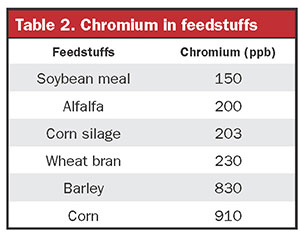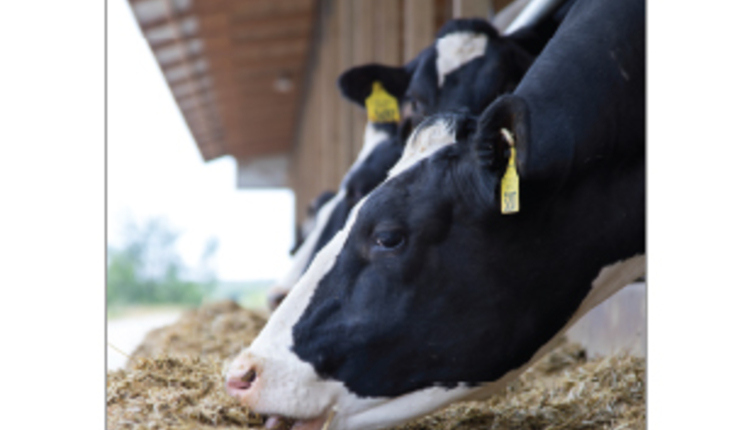Chromium is a relatively “new” mineral for dairy cows. The current Nutrient Research Council requirements (NRC 2001) do not list guidelines for appropriate levels of supplemental chromium in dairy rations. We do know that chromium plays an important role in carbohydrate metabolism by stabilizing insulin receptors that allow glucose to enter the cows’ cells. If the insulin receptors are not functioning properly, a condition called insulin resistance can occur.
Transition cows (21 days before calving to 21 days after calving) and high-producing cows more easily experience insulin resistance because of their tendency to run in a state of negative energy balance and struggle to manage glucose levels in their blood. Glucose in the ration from starch, sugar, and fiber sources are converted to volatile fatty acids (VFA) during the rumen fermentation process. Additionally, propionic acid is converted by the liver to glucose.
Chromium supplementation can reduce insulin resistance in cows under negative energy balance and lower the risk of ketosis. Dairy farmers are feeding chromium and nutritionists are recommending added chromium for these purposes. The typical ration chromium levels are listed in Table 1. In this article, we will address the format of chromium function, chromium costs, benefit to cost ratio when feeding chromium, and recommendations when feeding chromium.

The benefits are many
When we discuss transition cows, the conversation often starts with increasing dry matter intake, as it is key to elevating nutrient intake, supporting higher milk yields, and reducing metabolic disorders. Researchers feeding chromium report higher dry matter intakes can occur in early lactation cows with 4.4 pounds (2 kilograms) greater milk yield per 2.2 pounds (1 kg) of higher dry matter intake. Higher dry matter intake can also limit the risk of ketosis.

Outside of nutrient availability for milk production, chromium supplementation can benefit reproduction and overall health. Ovarian function uses glucose as an energy source. A study conducted by the University of Pennsylvania Veterinary College reported an improvement in conception rate, reduction in subclinical metritis, fewer days to first service, and additional viable oocytes in cows supplemented with 6 milligrams of supplemental chromium.
Further, glucose availability is also helpful to the immune system, which uses glucose as an energy source. Research at Cornell University suggests that supplemental chromium enhanced immune responses in early lactation to bacterial challenges in the uterus. Beef cattle researchers report supplemental chromium (400 to 1,000 parts per billion) alleviated the effects of stress in newly arrived cattle to feedlots by reducing blood cortisol levels. Stress and higher immune function raises the energy and glucose requirement.
Ketosis is caused by a shortage of blood glucose that leads to mobilization of body fat. If insulin receptors are not functioning correctly, a condition of insulin resistance can affect the cow. Researchers report insulin resistance can occur in close-up dry cows, early lactation, and mid-lactation cows more often than late lactation cows and far-off dry cows. Increased dry matter intake improved this situation.
Finally, glucose can be important under heat stress based on Iowa State research results that analyzed the impact of monensin and propionate production. Eight studies found a milk response in cows supplemented with chromium (range of 2.1 to 11.9 pounds more milk with an average of 5 pounds). They also had greater dry matter intake (0.7 to 6.1 pounds with an average of 3.2 pounds) compared to nonsupplemented or control cows. Supplemented cows received 3.6 to 10.8 milligrams per cow day with an average of 6.5 milligrams.
A summary of data reported the response to chromium supplementation was 3.7 pounds of milk per day from zero to 30 days, 5.7 pounds per day from 31 to 100 days in milk, and 3.7 pounds per cow per day over 100 days in milk compared to control (nonsupplemented) cows.
Weighing the benefits
The investment in chromium varies from 3 to 9 cents per cow per day depending on the marketing approaches. Check with your local supplier to get your chromium costs.
Based on the following assumptions, the benefit to cost ratio ranges from 15-to-1 or 3-to-1. Focusing only on improved milk yield of 4.4 pounds (2 kilograms) of milk priced at 18 cents a pound, the benefit (79 cents added milk income) with a chromium investment of 5 cents results in a ratio of 15-to-1. Including the added feed costs of 2.2 pounds (1 kg) at 11 cents a pound, the added feed costs is 24 cents for dry matter and 5 cents for chromium. That’s a total of 29 cents, or a benefit to cost ratio of 3-to-1. Adjust these calculations based on your costs. Although the benefits of lowered ketosis risk, improved fertility, and lower stress risks have not been considered in these ratios, they have additional value.
The level of supplemental chromium in the United States is controlled by Food and Drug Administration (FDA). The only source approved for dairy cattle in the U.S. is an organic source, chromium propionate, allowing up to 500 parts per billion (ppb) or 5 to 8 milligrams depending on dry matter intake.
As mentioned above, its current cost varies from 3 to 9 cents per cow per day for lactating cows with lower inclusion levels and costs for dry cows as dry matter intake is lower. The recommended feeding level for close-up dry cows, fresh cows, and early lactation cows is 500 ppb.
As we have learned from many research studies and farm experiences, getting cows off on the right foot during the transition period is critical to a productive and healthy lactation. Consider chromium supplementation during this time to boost cows’ abilities to utilize the nutrients they consume.











